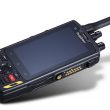A TNPP satellite-based simulcasting system for paging
Satellite-based simulcast paging provides solutions for crowded frequency and customer demand for larger coverage areas.
What is simulcasting? Simulcasting within a paging system is the process of synchronizing the emissions of the transmitters within the system’s common coverage areas. A typical three-transmitter, satellite-based system is shown in Figure 1 below and in Figures 2 and 3 on page 33. Distances from the geostationary satellite to cities A, B, and C range from 23,276 to 23,335 miles. Overlapping coverage due to pairs of transmitters on the ground is shown in Figure 2. If a pager is placed in the overlapping area between cities A and B, it must contend with two signals, one from each transmitter. For best pager performance, the signals from these transmitters must arrive at the pager at the same time. If they do, you have a simulcasting system.
Why simulcast? Paging providers simulcast to send as many pages as possible in a given time segment and to ensure that their paging customers receive their messages. Consider Figure 2 again. If a provider does not simulcast, let’s say with cities A and B, then all the transmitters for these sites must transmit one at a time. This ensures that a pager positioned midway between these transmitters will receive several copies of the page correctly. (System capacity is reduced, however, often to a third or a fourth of that for a simulcasting configuration.)
Typical TNPP satellite simulcasting The equipment for a typical satellite-based simulcasting system is shown in Figure 3 on page 33. The system consists of a central paging terminal, a master (transmitter) paging controller and one or more slave paging controllers. Timing for simulcasting is controlled by the master controller. Command pages in telocator network paging protocol (TNPP) format, are sent from the master, via the paging terminal and satellite, back to itself and to the slave(s). The periodic command pages synchronize the master and slave controllers, telling them when to gather pages and when to transmit pages accumulated in their buffers.
How does the system work? The paging terminal is central to this system, as it is to a terrestrial system. Pages are accumulated via dial-up telephone lines, from other terminals in adjoining cities in TNPP format and timing pages from the master paging controller. These pages are then uploaded to the satellite via the terminal’s TNPP output port. In many cases, providers share the uplink with one of the providers acting as a hub. TNPP inputs to the hub-from adjoining cities-are generally sent via dedicated (continuously connected) data circuits.
The constant stream of pages from the satellite, in TNPP format, arrives at the master site and slave sites in the same order and at nearly the same time. The time difference, of course, depends on the distance from the satellite to each controller site. The pages are received at each satellite receiver and directed to the serial port of each controller. The controllers must sort and store the TNPP page traffic into destination buffers. Pages with destinations not listed in the controller tables are discarded. Each controller then encodes the TNPP pages into POCSAG format and transmits them simultaneously. Some systems may have several exciters (transmitters) at each site. With this configuration, the controller must sort TNPP pages into exciter-destination tables and key first one and then another exciter. Such systems enhance coverage, and pagers with different receive frequencies are accommodated.
Timing considerations Reception by pagers situated directly between two transmitter sites is optimized, clearly if the paging signals from both sites arrive at the same time at the pager. CCIR recommendation 584 (Part 2 of The Book of the CCIR Radiopaging Code No. 1) specifies that these signals should arrive within less than 25% of the duration of one bit element of the page signal. For example, if your system is processing 1200-baud (1,200bps) POCSAG pages, then the difference in delay of the two signals should be less than 25% of 1/1,200th of a second, or 208ms. Sensitivity of pagers to the time difference of two identical paging signals depends, of course, on pager brand and model. All pagers following the POCSAG standard should meet this 25% criteria. We recommend that you set your system to achieve delays of less than 10%.
If two sites are separated from a satellite by a difference of 41.28 miles, as shown in Figure 1 and Table 1 for cities A and B, the pages retransmitted on VHF by these stations would arrive at a midpoint between them with a time difference of 206ms. Clearly, to meet the 10% criteria (or better), a delay must be added at the controller with the shorter satellite-earth path. Most controllers allow the paging technician to add this delay in one-mile increments, equivalent to roughly 5ms per mile.
Equipment considerations For the simulcasting system to work consistently (not just on the bench and not with just one, but several slaves), each satellite receiver and paging controller must be configured to operate exactly the same. Each component at each site-the satellite receiver, the controller and the exciter-must present the same signal delay, respond to the same to temperature changes, and buffer and transmit the same pages in the same order. All components must be tied to a common and accurate timing clock.
For example, the controllers in the system contain microprocessors, so the same revision of firmware must be run in all of them to ensure equal signaling delays. Each controller has its own crystal oscillator clock too. The crystals in these units are not synchronized and are not set at exactly the same frequency. They will vary over time and with temperature. A typical solution to this problem is to synchronize all of the controllers to a common clock using phase-lock loop (PLL) techniques. If the satellite receivers have a clock that is accurate and stabilized (kept on frequency) by a PLL based on the incoming page data stream, that clock may be used. Clock accuracy must be within 0.1%. If not, a common clock can be derived from a Global Positioning System (GPS) module.
System installation and testing Once a system of master and slave controllers is in place, a satellite uplink path for the TNPP command packets from the master controller must be established, and time delays to equalize the satellite-to-controller distances must be fine-tuned. Destination tables within the paging terminal must be reprogrammed to accept input-only TNPP command packets from the master paging controller and route them to the terminal’s TNPP output port. The output port may feed a satellite uplink directly or via another paging terminal (in another city) connected by a phone line. In the latter case, destination tables allowing command packets from the “master” controller source address may need to be entered.
The simplest way to check that the satellite-site delays are roughly equal is to take a pager to the common coverage areas and send it pages. A good double-check is to haul along a service monitor to display and listen to the pages received. If a pair of simulcasted signals sounds as “clean” as the transmission from one site, then the system is tuned.
With crowded frequencies-often being shared by two or more paging providers-and with customer demand for larger coverage areas, simulcasting by satellite makes sense. While providers do use terrestrial-based simulcasting systems (with a 72MHz control link sending POCSAG pages to a number of transmitters incorporating audio delay lines to equalize distance) satellite-based systems offer simpler installation and easily incorporate traffic from other providers. For those concerned with satellite rain fade or longer term loss of satellite feed, automatic telephone line back-up systems can be easily installed.












